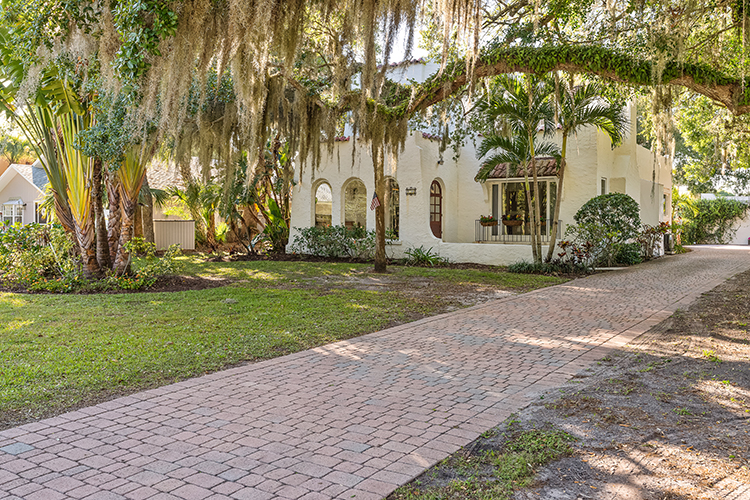
Good news for anyone looking for a house in Vero Beach who loves historical architecture: A classic Mediterranean Revival home on Royal Palm Place just came on the market.
One of the original homes built in the Royal Park subdivision adjacent to the Vero Beach Country Club in the 1920s, the house has been lovingly preserved by current owners Annabel Robertson, executive director of the VNA Foundation, and her husband Benjamin Robertson.
Known as the Cleary House, after prior longtime owners Gerald and Mary Louise Cleary, who founded the Patio Restaurant and operated it for decades during its heyday, the 4-bedroom, 2.5-bath, 2,350-square-foot home comes with a swimming pool and cabana – and sweeping views across the Vero Beach Country Club golf course.
Historical elements include original heart pine flooring, arched entrances, a tongue and groove ceiling, decorative iron and ceramic pieces, and a stucco fireplace. The rooms are large and bright, filled with sunlight that floods in through numerous large windows.
Though the home has been thoroughly updated for modern life, it retains its romantic “Roaring Twenties” charm and Annabel hit the brakes when she noticed it for the first time while driving down Royal Palm Place 20 years ago.
“They were just putting the ‘For Sale’ sign in the yard as we drove by and we stopped to look. As soon as I stepped inside, I knew it was our house.
“The really blissful thing about living in this house is you can sit in the backyard by the pool and feel like you are far away from everything when you actually are three minutes from Fresh Market and five minutes from the beach,” Annabel says. “Basically, you are no more than 10 minutes away from anything you need, so it is a kind of paradise.
“I think it is neat that it was one of the original houses built back in 1925 when the Royal Park Development Company built the country club and the first 26 houses. This is one of the last of those homes.”
Waldo Sexton, the famed Vero pioneer who built the Driftwood Resort, Ocean Grill and much else in the city, was president of the development company and is said to have planted with his own hands the now towering palms that line the curving roadway in front of the Robertsons’ house.
“The home is truly a historical showpiece,” says listing agent Mazie Regan, a broker associate with Daley & Company Real Estate. “It’s full of character and charm you cannot replicate nowadays. It’s a one-of-a-kind showstopper. The current owners have been outstanding stewards of the home and are now seeking its next good stewards.”
Annabel grew up in South Florida, where she fell in love with Addison Mizner’s Med Revival and Spanish Colonial Revival homes and she chose Regan as her agent because of Regan’s interest in historical architecture and expertise in selling classic homes.
The Mediterranean Revival style – which was popular in the 1920s and ’30s, originated in Florida and California in the wake of the Pan American Exhibition in San Diego and the opening of the Panama Canal – is the most notable type of historical architecture found in Vero Beach, where it is expressed in a number of handsome commercial buildings and many beautiful homes.
A document in the archive center in Vero’s main library states Mediterranean Revival homes are characterized by “flat or [low-pitched] hip roofs; usually some form of parapet; ceramic tile roof surfacing; stucco facades; flat-roof entrance porches, commonly with arched openings supported by square columns; [tall] casement and double-hung sash windows; and ceramic tile decorations.”
Prominent examples of the style in Vero Beach include the Farmers Bank building, now Vero Furniture Mart, the Theatre Plaza and the Pocahontas Apartments, all on 14th Avenue downtown. Brazilian Court at 1805 19th Place and the Royal Viking at 706 Royal Palm Boulevard are two other apartment buildings in the Mediterranean/Spanish Colonial Revival style that are familiar to Vero residents.
Med Revival homes are scattered through older parts of mainland Vero Beach, with a heavy concentration in the Osceola Park neighborhood, and there are some great, almost palatial examples on the island in Old Riomar.
Frederick Trimble, one of the most well-known architects who worked in the style in Florida, designed a number of buildings in and around Vero including the Royal Park Inn (now demolished), Farmers Bank, Theatre Plaza and Brazilian Court, which was called the Orange Apartments when it was built in the mid-1920s.
The Robertsons – who are relocating in Vero – raised their four children in the house at 850 Royal Palm Place, and Regan thinks a young family with growing children may well end up purchasing the property from them – a family that appreciates historic architecture and maybe country club life.



